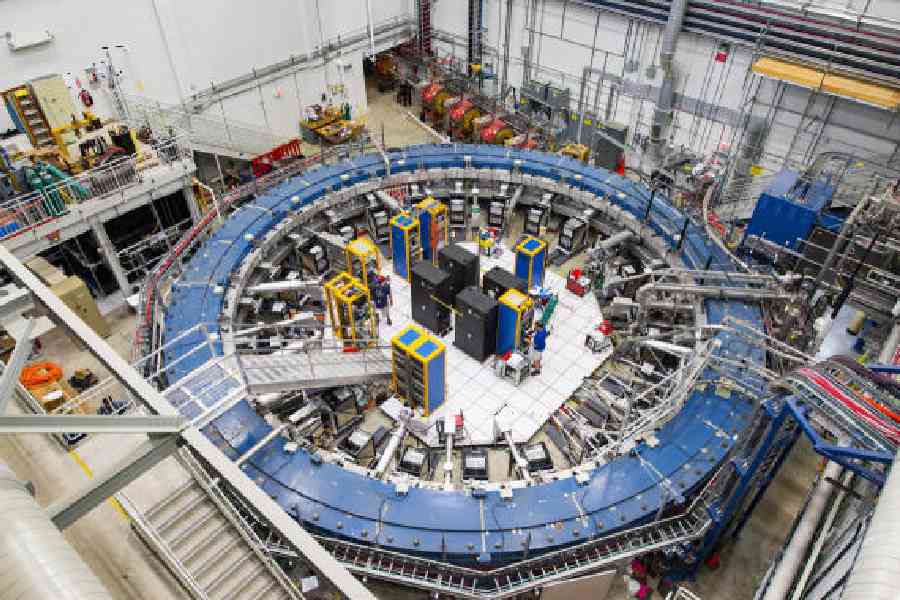It has been 12 years since physicists transported a giant magnetic ring down the Atlantic coast, around Florida, up the Mississippi river and across two interstates to Batavia, Illinois, US. Recently, the team behind that ring unveiled their final result: the most precise value yet recorded for the tiny wobble of a subatomic particle called the muon.
Physicists hoped that the measurement, submitted to the journal Physical Review Letters, would open a window to new types of energy and matter that have only been theorised.
But a glaring problem remains. Physicists have predicted two distinct values for the muon’s wobble but aren’t sure which is correct. The new result matches one prediction, but until the other prediction can be satisfyingly explained away, scientists won’t know if they have uncovered evidence of new physics.
Muons are similar to electrons but far heavier and unstable in nature. When placed in a magnetic field, they precess or wobble like a spinning top. The speed of that wobble depends on a property of the muon related to its internal magnetism, known to physicists as g.
Absent any nearby particles, g should equal exactly 2. But according to quantum theory, even empty space isn’t truly empty: it brims with so-called virtual particles of all kinds, blipping in and out of existence. They persist long enough to interact with the muon, slightly changing its wobble and pulling g away from 2.
Peter Winter, a physicist at Argonne National Laboratory and a spokesperson for the Muon g-2 Collaboration, which ran the experiment at Fermi National Accelerator Laboratory, or Fermilab, likened the effect to the way that leaves on a tree shift in the wind. The force is unseen, but its interaction with the leaves is predictable depending on the strength and direction of the wind. Measuring whether the leaves moved as expected, he said, would indicate whether your wind model was correct.
Physicists rely on the collection of particles and forces encapsulated in the Standard Model — their best theory for how the universe looks and behaves at subatomic scales — to predict how much g deviates from 2. They call this deviation g-2 (pronounced “g minus 2”). Their hunch, however, is that the Standard Model is incomplete because it lacks an explanation for key puzzles in physics, like the nature of dark matter or why certain particles known as neutrinos can have mass.
If there are undiscovered particles or forces at play, measuring g-2 will help physicists find them, because its value will be different from what the Standard Model predicts. But calculating a prediction has proved notoriously difficult. Traditionally, theorists have avoided a direct calculation, instead compiling relevant data from particle experiments around the world and working backward to achieve a theoretical prediction for g-2.
In the meantime, experimentalists have been busy measuring. In the 1990s, scientists at Brookhaven National Laboratory in New York,US, began operating a 50-foot-diameter magnet shaped like a ring. Muons raced around that ring, their wobbles recorded by detectors along its edge.
The outcome of that experiment was a tantalising result for g-2 — the deviation of g from 2 — that seemed to defy the theoretical prediction. The discrepancy between what they measured and the theoretical prediction for g-2 was at a level of 3.7 sigma, in the units of uncertainty used by physicists. (A 5-sigma discrepancy is the general standard for claiming a discovery, corresponding to a 1 in 3.5 million chance the result is a fluke.)
A dozen years later, in a grand feat of logistics, physicists spent 35 days inching the magnetic ring by barge and truck from Brookhaven to Fermilab, where a more powerful source of muons would allow them to gather more data with higher precision. In 2021, the scientists confirmed the g-2 value initially measured at Brookhaven. The mismatch between the experiment and prediction rose to 4.2 sigma and then over 5 sigma in 2023.
But physicists stopped short of claiming a discovery because a different, more direct way to predict g-2 from the Standard Model had surfaced. The method, which involves using supercomputers to simulate the universe as a four-dimensional grid of space-time points, relies on no data at all. That is advantageous over the earlier prediction, which did rely on experimental data, some of which are now contradictory.
Comparing the newer prediction to the g-2 value measured ever more precisely at Fermilab shows no discrepancy between theory and experiment, suggesting no discovery at all.
Theorists have tried to reconcile their two predictions ever since, even as Fermilab scientists forged ahead with ever more precise measurements of the muon’s wobble. Their final value for g-2, calculated from hundreds of billions of observed muons, is 0.00233184141.
It is the same value measured at Brookhaven more than two decades ago, but with a much higher precision of 127 parts per billion. That is as precise as measuring the length of a football field with an error less than the width of a hair.
Now the ball is in the theorists’ court, said Marco Incagli, a physicist at the National Institute of Nuclear Physics in Italy and a spokesperson for the Fermilab collaboration.
NYTNS











